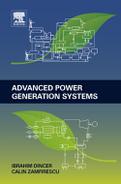6.6 Concluding Remarks
In this chapter we discuss nuclear energy generation from a sustainable perspective. The nuclear theory is revisited along large lines, with a focus on derivation of binding energy. The nuclear fuel cycle is introduced. The method of producing nuclear heat is explained in detail, as is the possibility of quantifying the efficiency of nuclear heat generation on an energy and an exergy basis. The main nuclear reactors are revisited and various applications of nuclear energy discussed. Some examples demonstrate briefly the calculation of nuclear reactor heat generation and efficiency in terms of useful heat delivered with the primary nuclear energy used. Both energy and exergy efficiency are introduced. Apart from the most common use of nuclear energy—for electric power production—there is major interest in nuclear energy as a source of process heat. Nuclear process heat can be used for hydrogen production, desalination, or other processes. Three case studies are also presented in this chapter to provide better coverage and understanding.
Study Problems
6.1. Compare uranium fuel and gasoline in terms of energy content per unit of volume and mass.
6.2. Define and explain binding energy.
6.3. Calculate the binding energy of uranium isotopes.
6.4. Determine the decay time of carbon-14 if N/N0 = 0.1.
6.5. How one can estimate the available energy from nuclear fusion?
6.6. Explain how a nuclear reaction can be controlled.
6.7. Define the energy and exergy efficiency of nuclear thermal energy generation.
6.8. Define the term “nuclear cross-section.”
6.9. A reactor comprises a n = 40,000 cylindrical fuel assembly distributed over a circular cross-section of the reactor with the radius of Rr = 1.8 m. The average energy generated of fissionable material in this configuration is eg = 175 MeV per interaction. The generated heat is 3 GW. Calculate the heat generation at a distance (r) from the fuel rod axis and the maximum heat flux.
6.10. The fuel rod radius in the example above is Rf = 7 mm and is clad with a Zircaloy shell of t = 0.7 mm thickness and the rod height is z = 5.7 m. Calculate the heat flux and the temperature of the cladding outer surface provided that the core temperature is Tc = 2600 °C.
6.11. Describe the principle of a pressurized water reactor and that of a boiling water reactor and emphasize the differences between them.
6.12. Describe the CANDU reactor and explain the role of the heavy water.
6.13. List the three top countries having uranium fuel reserves.
6.14. What do you understand by the “process of conversion?”
6.15. Define the unit of measure “Sievert.”
6.16. What is the advantage of nuclear hydrogen production?
6.17. Do a case study for a district heating cogeneration plant with nuclear energy based on the diagram in Figure 6.32.
6.18. Rework Example 6.10 with other reasonable assumed values for data input.
6.19. Rework Example 6.9 for data corresponding to a CANDU reactor of 600 MW.
6.20. Design a system using nuclear heat cogeneration for aluminum production. Make a brief documentary study to determine the heat demands. Use the very high nuclear reactor of Generation VI for heat generation.
